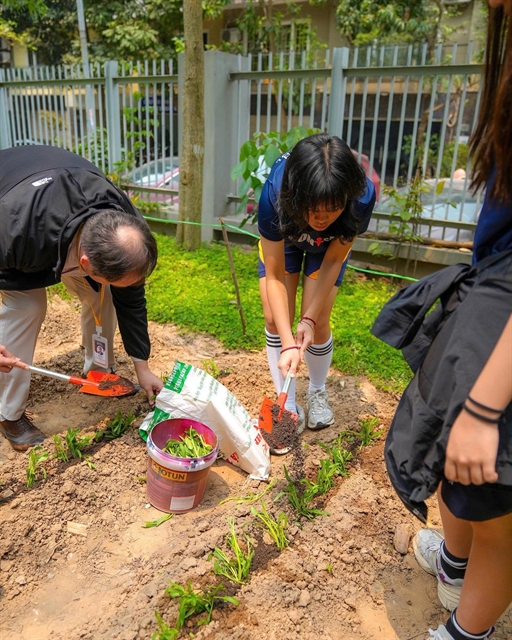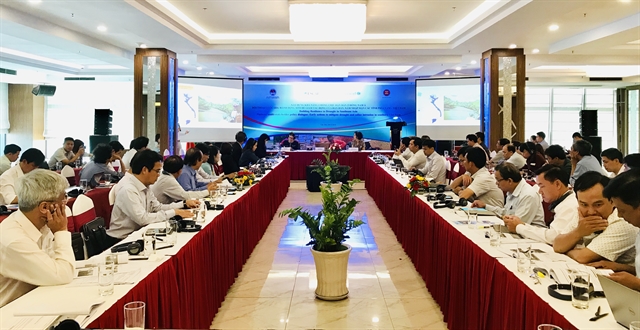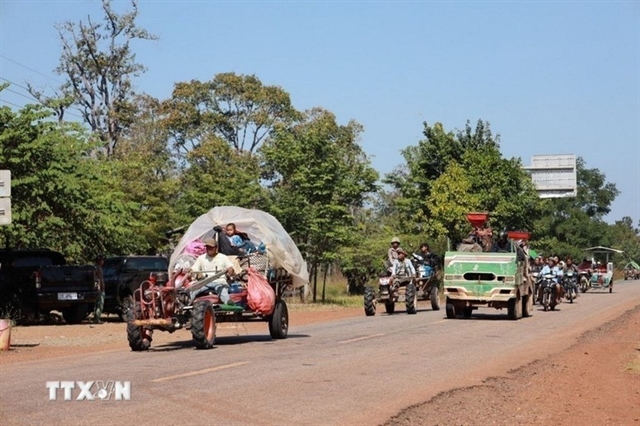 Environment
Environment


|
| Speakers at the Building Resilience Drought Southeast Asia dialogue held yesterday in Cần Thơ. VNS Photo Bồ Xuân Hiệp |
Bồ Xuân Hiệp
CẦN THƠ — ASEAN-member countries have vowed to take immediate action to resolve problems caused by worsening drought in Southeast Asia, especially in Việt Nam’s Mekong Delta region, which is especially susceptible to global warming.
Speaking at a meeting on Tuesday in Cần Thơ, Intani Nur Kusuma, senior officer at the Disaster Management and Humanitarian Assistance Division of the ASEAN Secretariat, said that a declaration on drought would be adopted by leaders at the ASEAN Summit to be held in Việt Nam in November next year.
ASEAN has worked closely with relevant sectors to help the ASEAN Committee on Disaster Management draft the declaration, she said, adding that drought-related activities need to be integrated into the future action plan of ASEAN.
To mitigate the impact, drought risk assessment and early-warning services should be improved through the sharing of data from space-based technologies.
Risk-financing instruments as well as improvement of people’s awareness of the effects of drought are also needed.
Tiziana Bonapace, director of the Information and Communications Technology and Disaster Risk Reduction Division of the Economic and Social Commission for Asia and the Pacific (ESACP), told Việt Nam News: “Climate change has already happened. Now is the time to adapt instead of fighting it.”
“Southeast Asia is faced with intensification and a changing geography of drought, and of disaster risk in general, as climate change converges with social, environmental and economic stresses.
“Regional co-operation, especially among nations benefiting from the Mekong River, is needed to support national efforts to manage drought through data, technology, innovations, policy and financing options,” Bonapace said.
“The best solution is no single solution but a multi-approach solution,” she added. “Negotiations and dialogue are also needed among all the countries involved based on science and technology and evidence.”
“Our new analysis shows disasters in the region are having more impact than previously thought. Much of the increase is due to the quantification of agricultural drought losses, which was not reported before,” she noted.
Nguyễn Trường Sơn, deputy head of the Việt Nam Disaster Management Authority, said the Mekong Delta and Central Highlands regions were facing abnormal weather that could be attributed to climate change.
The Mekong River levels in June and July significantly fell compared to previous years, raising concern of exacerbated drought and saline intrusion for the entire Mekong Delta in the 2019-20 dry season.
In the Central Highlands, rainfall in the dry season has dropped considerably compared to previous years, while temperatures have been 0.5-1 degrees Celsius higher than average, sparking serious droughts that have threatened vast tracts of natural forests as well as crops.
Economic losses
No Southeast Asian country can afford to ignore drought when trying to mitigate the economic impact of natural disasters, according to experts.
Bonapace said the significance of economic losses due to agricultural drought was consistent across all countries for which data is available.
“The agricultural losses are highest in Indonesia. In Việt Nam, we estimate it to be around US$6.5 billion or 3 per cent of GDP,” she said.
Disasters continue to erode economic gains. Ultimately this means that disasters will limit the ability of economic growth to eradicate poverty.
“According to our study, the economic models show that without disasters, Việt Nam is expected to completely eradicate extreme poverty by 2030,” Bonapace said.
According to the Asia-Pacific Disaster Report 2019, annual economic losses in Asia Pacific more than quadruple when slow-onset disasters, most notably drought, are added to the region’s disaster risk landscape.
The average annual loss for the region is $675 billion, of which $405 billion, or 60 per cent, is drought-related agricultural losses.
In Southeast Asia, the average annual loss is higher than the Asia-Pacific regional average, reaching $86.5 billion or 3 per cent of the regional GDP.
The average annual loss is highest in Cambodia, Myanmar, Laos, Việt Nam, and the Philippines.
According to the 2019 Report Ready for the Dry Years report, though starting slowly, drought can have a devastating cumulative impact, striking hardest at the poor and heightening inequality and degrading land, all of which increases the prospects of conflict.
According to the report, there will be many more dry years ahead, and the area affected by drought is likely to shift and expand.
The report was jointly produced by ESCAP and ASEAN as part of their disaster-risk reduction efforts.
Dying river
Experts have recently expressed concern about a number of dams impeding the Mekong Delta’s flow, drying up many parts of the once fast-flowing river and leaving the region facing serious drought.
Lê Công Thành, deputy minister of the Ministry of Natural Resources and Environment, said an increasing number of dam constructions in the Mekong River were “posing a great burden on the 4,700-kilometre Mekong River basin, especially on the Mekong Delta”.
As a result, millions of people who depend on the river for their livelihoods in Việt Nam, China, Laos, Myanmar and Thailand will be seriously affected.
The Mekong River Commission, a regional intergovernmental agency that manages the river’s water resources, said that all the “dams in the upstream Mekong River countries contribute to worsening drought in the region”.
The river’s water levels last month recorded their lowest level in 60 years. Other estimates suggest that water levels have dropped to their lowest level in a century, the commission said.
Lower freshwater river levels mean that saltwater levels in the delta could rise, threatening rice-growing and agriculture in general, while agriculture irrigated by the river could suffer if nutrient-rich sediment is blocked from flowing downriver by dams.
The Mekong River, which originates in China and snakes through five Southeast Asian countries, is emerging as a new security flashpoint, experts have warned.
The river begins in the Tibetan Plateau, stretches through much of mainland Southeast Asia, and ends in the Mekong Delta.
The one-day Building Resilience Drought Southeast Asia dialogue was co-organised by the Việt Nam Disaster Management Authority, ESCAP, and the ASEAN Secretariat. — VNS

|
| Intani Nur Kusuma, senior officer at the Disaster Management and Humanitarian Assistance Division, speaks at the Building Resilience Drought Southeast Asia dialogue held yesterday in Cần Thơ. VNS Photo Bồ Xuân Hiệp |




